“This statue has to go,” Boston artist Tory Bullock said Thursday of “Freedmen’s Memorial Monument” in Boston’s Park Square.
As racist monuments are coming down across the United States in response to the movement for Black lives, Bullock’s statement on Facebook is part of a growing call to remove the monument to President Abraham Lincoln’s Emancipation Proclamation during the Civil War, which freed Black Americans from slavery.
“This statue has been bothering me since I was a child, and I never really understood how messed up it was until recently when I see everybody tearing down all these statues across the world,” Bullock says in an accompanying video. “And I’m here scratching my head like why is this still up?”
The statue, which has been in Park Square since 1879, is a copy of an 1876 Washington, D.C., monument funded entirely by African Americans to honor the assassinated President Abraham Lincoln and celebrate the abolishment of slavery in the United States. It depicts Lincoln standing in a suit, holding the Emancipation Proclamation in one hand and waving the other above a Black man crouching beside him, who wears just a loincloth and broken shackles. The freedman is an idealized portrait of Archer Alexander, who escaped from slavery in Missouri in 1863, and is often said to be the last man recaptured under the Fugitive Slave Act. At the bottom of the Boston statue it reads: “Emancipation.” The base is inscribed: “A race set free / and the country at peace / Lincoln / rests from his labors.”
“That image of a Black dude on his knees, does that make you feel powerful? Does that make you feel respected? Does that make you feel good?” Bullock asks in an accompanying video. “Given my experience, it’s how a lot of White people actually view Black poeple.”
“It’s supposed to represent freedom but instead represents us still beneath someone else,” Bullock wrote in launching an online petition to “Remove The Emancipation Memorial/Freedman Statue.” “I would always ask myself ‘If he’s free why is he still on his knees?’ No kid should have to ask themselves that question anymore. If you feel the same then sign the petition!”
Already nearly 4,900 people have signed.
Artist Steve Locke, though, writes that there’s an “uninformed assumption that the Emancipation Group comes from a place a white supremacist contempt. This is simply not true.”
Locke is a New York-based artist who lived in Boston for many years and in 2018 and ’19 tried to create an “Auction Block Memorial at Faneuil Hall: A Site Dedicated to Those Enslaved Africans and African-Americans Whose Kidnapping and Sale Here Took Place and Whose Labor and Trafficking Through the Triangular Trade Financed the Building of Faneuil Hall.” Locke gave up work on his proposal in the face of opposition from the Boston branch of the National Association for the Advancement of Colored People.
“This statue is a copy of the Freedman’s Memorial: the first statue commissioned AND PAID FOR by freed slaves in the United States to honor Abraham Lincoln and to commemorate emancipation,” Locke wrote on Facebook yesterday. “…It’s not an anti-Black image. It is a copy of a memorial paid for by Black people at their instruction. … I think it is really important that people learn about the monuments, their creators, their funders, and their contexts before they decided that they should be removed. Just because the internet can separate an image from its context doesn’t mean that we should.”
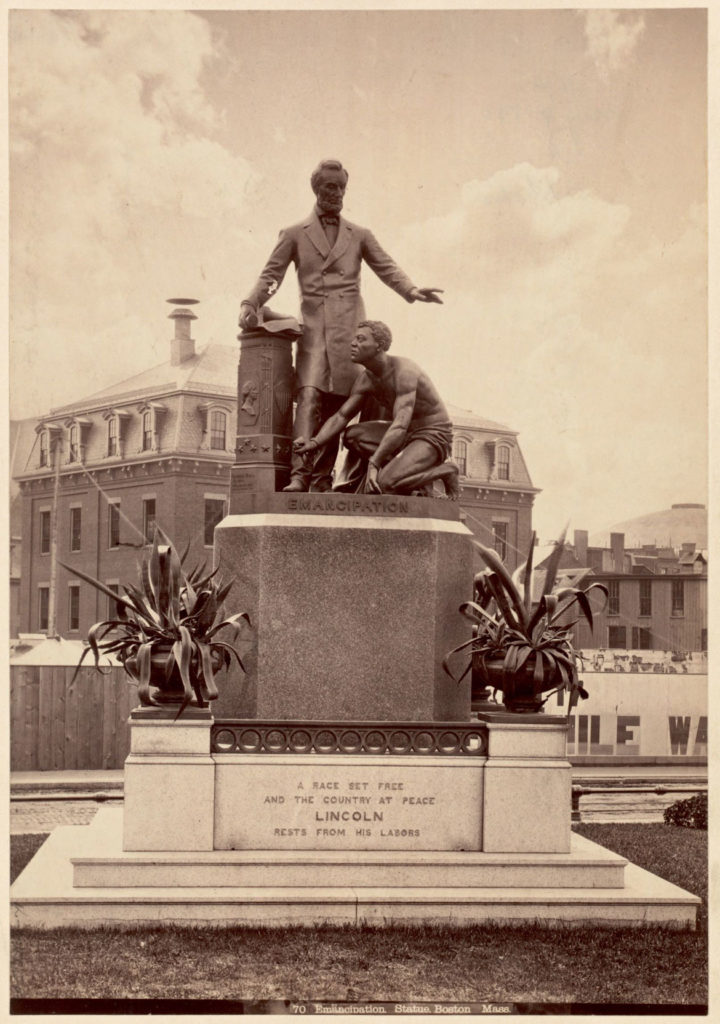
‘Their Best Friend On Earth’
On April 14, 1876, the 11th anniversary of Lincoln’s assassination, church bells chimed as a parade of Black Americans, marching bands, Black soldiers, police riding horses, and a carriage carrying the preeminent abolitionist Frederick Douglass processed from Washington, D.C.’s K Street through the grounds of the Executive Mansion to Lincoln Park.
There a new statue stood draped and a speakers stand had been erected, according to an 1876 pamphlet describing the “Inaugural ceremonies of the Freedmen’s Memorial Monument to Abraham Lincoln.” A crowd of 25,000 people–including U.S. Supreme Court justices and President Ulysses S. Grant–listened to a prayer, a reading of the Emancipation Proclamation, and music.
Then James E. Yeatman spoke. The White man was president of the Western Sanitary Commission of St. Louis, which ran hospitals and cared of families and orphans of soldiers, refugees and freedmen during the Civil War.
Yeatman said the “Freedmen’s Memorial Monument” had begun with a donation from Charlotte Scott, a woman of about 60 who had been born enslaved in Campbell County, Virginia, and taken by her owners to Marietta, Ohio, where she continued to work for the family when freed after the war.
“The colored people have lost their best friend on earth! Mr. Lincoln was our best friend, and I will give five dollars of my wages towards erecting a monument to his memory,” Scott said when Lincoln was murdered, according to Yeatman.
In May 1865, as word of the project spread, Black infantry soldiers occupying traitor Mississippi contributed thousands of dollars.
‘Go For Your Freedom’
In 1869, William Greenleaf Eliot, a White leader of the Western Sanitary Commission visited the White sculptor Thomas Ball in Florence, Italy. Ball was born in Charlestown in 1819, and sculptured the iconic 1869 statute of George Washington in the Boston Public Garden.
In Ball’s studio, Eliot saw a sculpture carved from white Italian marble that Ball said he made upon hearing of Lincoln’s assassination. The original–believed to have ended up in the collection of the Kemper Art Museum at Washington University in St. Louis–was half life-sized. It showed Lincoln holding a scroll symbolizing the Emancipation Proclamation, which rests on square column inscribed with a profile of George Washington, shields, stars and other American symbols. Lincoln waves his left hand above a crouching a freedman, as if bestowing liberty. The freedman is nude save for a loin cloth, broken shackles and a Liberty cap (a symbol in Ancient Rome of freed slaves and adopted during the French Revolution as a symbol of freedom).
The freedman’s pose echoes an icon used by American and English anti-slavery efforts since it was adopted by the Society for the Abolition of Slavery in England in the 1780s. That design depicted a kneeling Black man, wearing just a loincloth, and bound at wrists and ankles in chains, who pleads, “Am I not a man and a brother?”
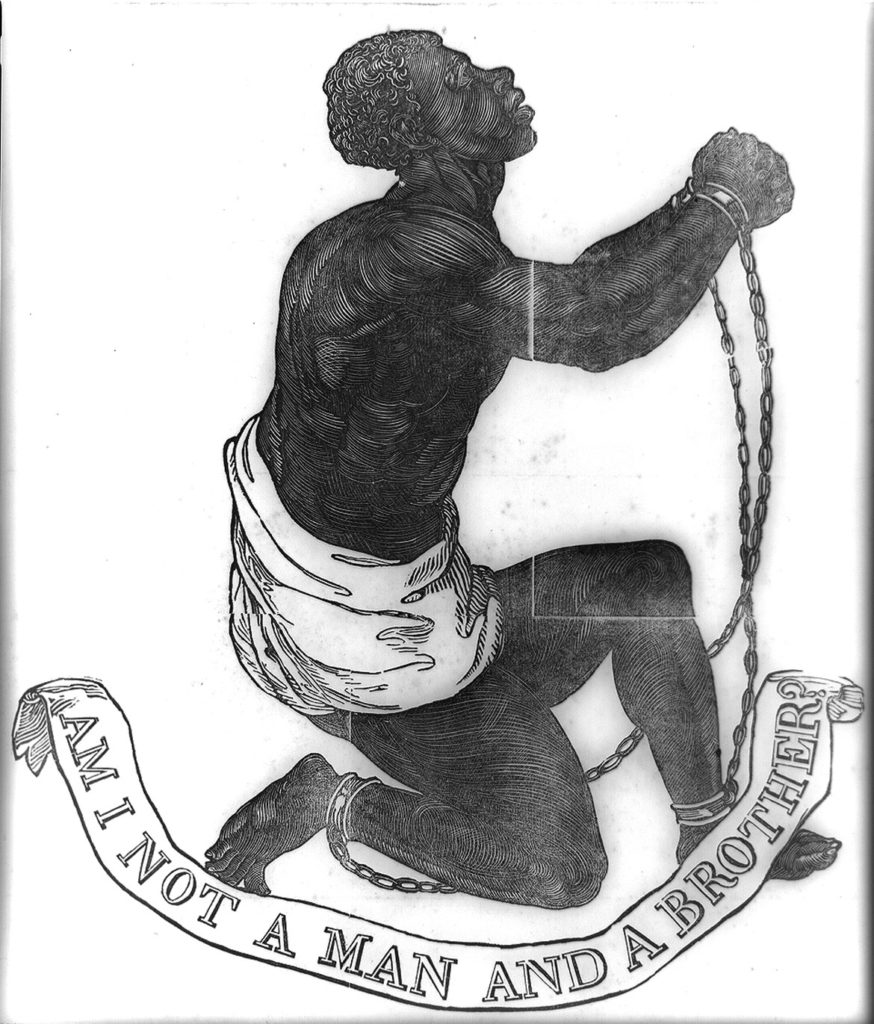
Eliot recommended that Ball’s design be picked for “Freedmen’s Memorial Monument.”
An alternate proposal, showing Lincoln with statues of black Union soldiers in uniform and bearing rifles, would be rejected for being too expensive.
At the unveiling, Yeatman said they got Ball to make changes that would make “the emancipated slave an agent in his own deliverance,” by moving his right hand forward to suggest him breaking the chains that bound him.
Another alternate version from Ball in Harvard’s collection has the crouching freed man wearing a liberty cap and shows the Lincoln Lincoln holding a shield that pins the Emancipation Proclamation scroll atop a pile of books.
Yeatman said they also had Ball remove the hat and change the freedman from an imagined figure to a depiction inspired by Archer Alexander, based on a photo Eliot provided. Ball wrote in his autobiography “My Threescore Years and Ten” that he used mirrors to model the freedman’s position himself.
“Go for your freedom, ef you dies for it,” Alexander recounted saying to himself as he escaped from slavery in St. Charles County, Missouri, in 1863.
Alexander made his way to St. Louis, where he found work as a gardener for William Greenleaf Eliot, a New Bedford-born, Harvard-trained minister who founded the First Congregational Society of St. Louis. Eliot tried to help Alexander legally secure his freedom, but slave-catchers arrived, beat Alexander up, handcuffed him and abducted him. Military authorities helped Eliot recover Alexander and keep him free until slavery was outlawed.
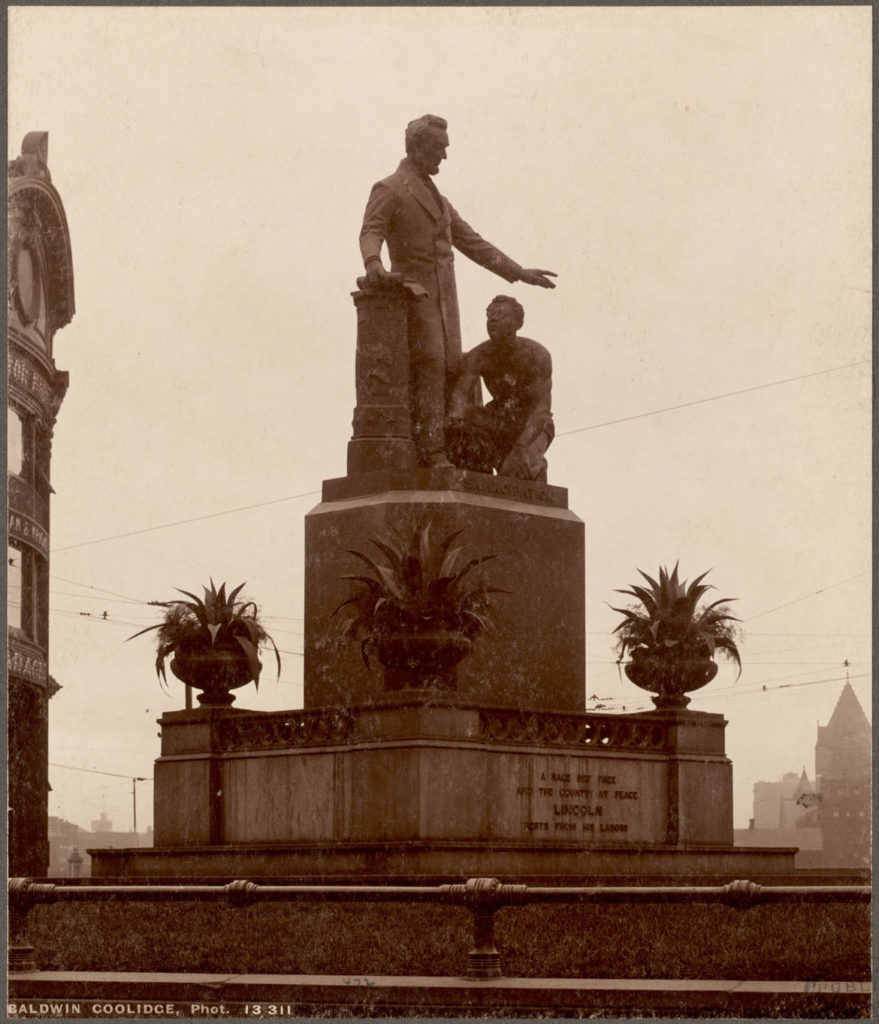
‘On His Knees’
After Yeatman finished speaking at the Washington unveiling, President Ulysses S. Grant stood for a moment of silence. Then he pulled the cord to unveil the bronze figures. The crowd cheered.
A bronze plaque attested that the “Freedmen’s Memorial Monument” was built “with funds contributed solely by emancipated citizens of the United States. … The first contribution of five dollars was made by Charlotte Scott, a freed woman of Virginia, being her first earnings in freedom.”
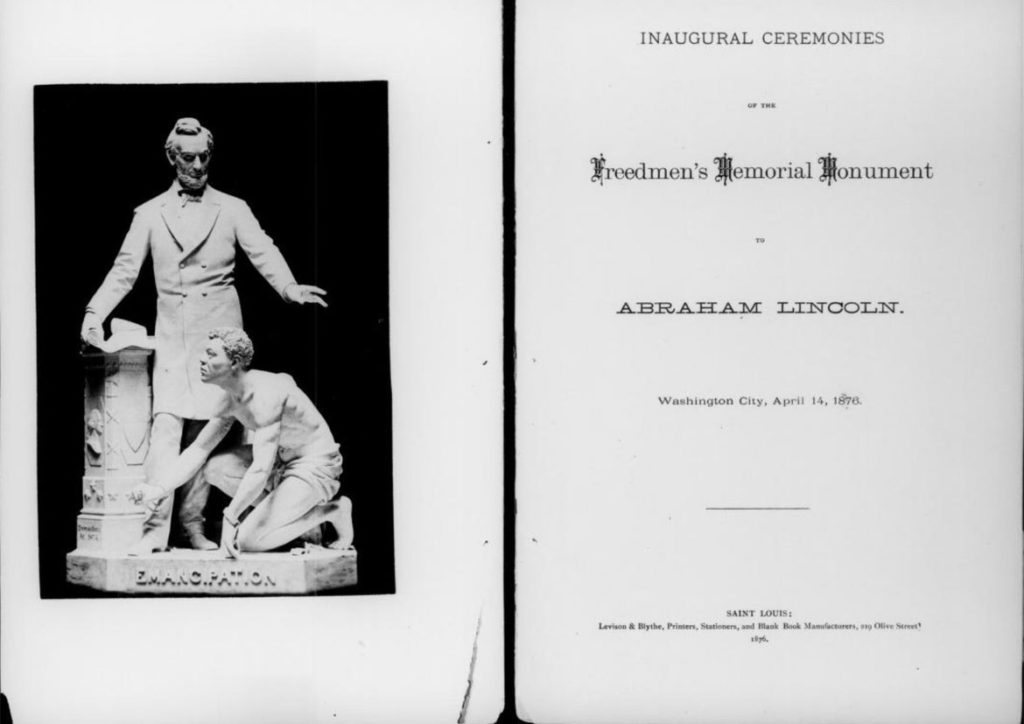
A poem was read, then Frederick Douglass rose. He was around 60 then. He’d escaped slavery as a young Black man to become an activist statesman.
“Harmless, beautiful, proper and praiseworthy as this demonstration is, I cannot forget that no such demonstration would have been tolerated here 20 years ago,” Douglass told the crowd. “…We are here to express, as best we may, by appropriate forms and ceremonies, our grateful sense of the vast, high and preeminent services rendered to ourselves, to our race, to our country and to the whole world, by Abraham Lincoln.”
But Lincoln “was pre-eminently the white man’s President, entirely devoted to the welfare of white men” and willing during his first year in office to deny the rights of African Americans, including the return of escaped slaves, Douglass said. “Though the Union was more to him than our freedom or our future, under his wise and beneficent rule we saw ourselves gradually lifted from the depths of slavery to the highs of liberty and manhood.”
Eliot would write in the 1885 book, “The Story of Archer Alexander from Slavery to Freedom, March 30, 1863”: “When I showed to [Alexander] the photographic picture of the ‘Freedom’s Memorial’ monument, soon after its inauguration in Washington, and explained to him its meaning, and that he would thus be remembered in connection with Abraham Lincoln, the emancipator of his race, he laughed all over. He presently sobered down and exclaimed, ‘Now I’se a white man! Now I’se free! I thank the good Lord that he has ‘livered me from all my troubles, and I’se lived to see this.'”
But according to historian John Cromwell, who witnessed the ceremonies, Douglass commented as an ad-libbed aside that the “Freedmen’s Memorial Monument” “showed the Negro on his knees when a more manly attitude would have been indicative of freedom.” (As Kirk Savage reported in his 1997 book “Standing Soldiers, Kneeling Slaves: Race, War, and Monument in Nineteenth-Century America.”)
President Abraham Lincoln himself had faced nearly this very situation in real life near the end of Civil War. Two days after Confederate forces evacuated Richmond, on April 4, 1865, Lincoln arrived by boat to visit the South’s former Capital. Admiral David D. Porter, who traveled with the president, recalled in his 1885 book “Incidents and Anecdotes of the Civil War” (page 295) that a Black man recognized Lincoln as he landed. “Here is the great Messiah!” the man said, “He’s come at last to free his children from their bondage!”
“He fell upon his knees before the president and kissed his feet. The others followed his example, and in a minute Mr. Lincoln was surrounded,” Porter recalled. “Mr. Lincoln looked down on the poor creatures at his feet; he was much embarrassed at his position. ‘Don’t kneel to me,’ he said. ‘That is not right. You must kneel to God only, and thank him for the liberty you will hereafter enjoy.'”
Porter, however, thought: “What a fine picture that would have made—Mr. Lincoln landing from a ship-of-war’s boat, an aged negro on his knees at his feet, and a dozen more trying to reach him to kiss the hem of his garments! In the foreground should be the shackles he had broken when he issued his proclamation giving liberty to the slave.”
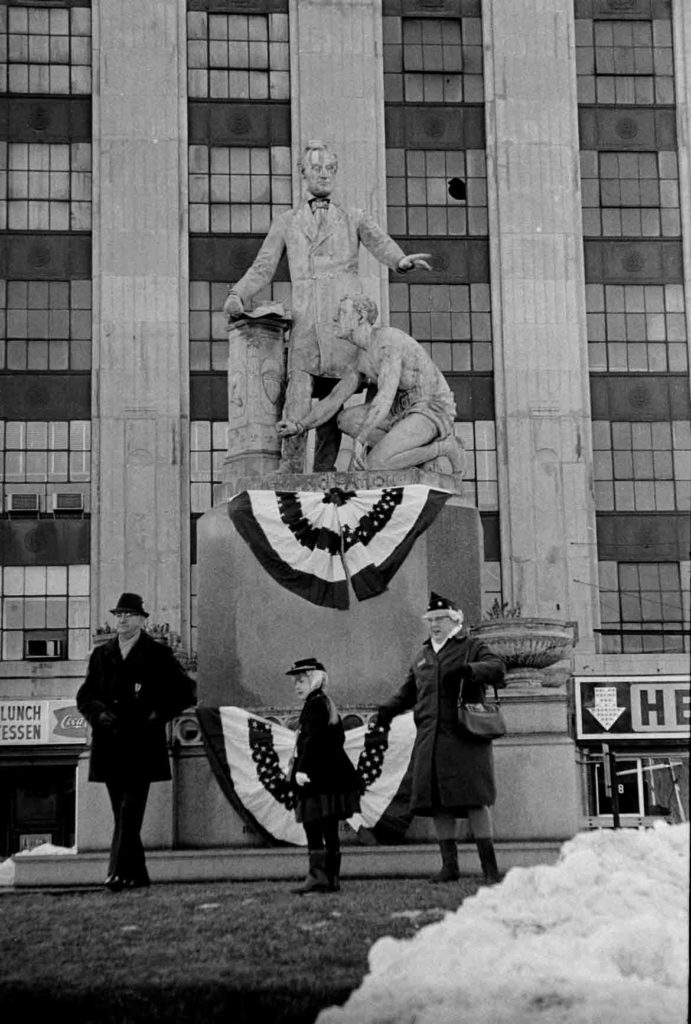
Feeling That Comes With Seeing An Image Of Yourself On Your Knees
“If it’s not good enough for Frederick then it’s not good enough for me,” Bullock responded to Locke on Facebook yesterday.
A copy of the Washington sculpture debuted in Boston’s Park Square in 1879 as a gift from wealthy benefactor and abolitionist Moses Kimball. At dedication ceremonies held inside Faneuil Hall because of inclement weather, Alderman Charles Breck described the monument as “representing the most interesting, the most important, and the most sublime event that has ever transpired in the history of the world, resulting in the freedom of more than three millions of the colored race, who had been held in the cruel bondage of slavery since the early settlement of our country.”
Early in a long oration, Mayor Frederick Prince said, “May this eloquent memorial endure as long as things made by human hands are permitted to endure; as long as the human mind retains its capacity to know that liberty is the gift of Heaven to man, and that resistance to tyranny is obedience to God.”
Still, the sculpture in Washington and the Boston copy have been controversial. Ball’s design has been criticized as paternalistic and for downplaying the active role African Americans had in ending slavery.
In 1982, The Boston Globe reported that the statute “long has raised the hackles of some Blacks in Boston.” With a need for it to be temporarily removed during redevelopment of Park Square, there was a proposal to permanently take the statue away from there.
“Some people say it appears as if the crouching figure is shining Lincoln’s shoes,” The Globe continued. “They say it makes Lincoln appear to be ‘The Great Patronizer.'” But the sculpture stuck around and was restored in 1987.
In 2017, Raul Fernandez, now Associate Dean for Equity, Diversity & Inclusion and lecturer at Boston University, published an essay on Medium digging into the monument’s history and calling for removal: “A monument to white supremacy stands uncontested in our own back yard.”
“The shame of this depiction belongs to those who came before us,” Fernandez wrote, “but every day that passes makes it more and more our own.”
Bullock wrote on Facebook yesterday: “There’s a very specific feeling that comes with seeing an image of yourself on your hands and knees while some white guy standing above you. I don’t care if it was paid for by us, I don’t care if it was created by them, this isn’t how we see ourselves anymore. If that’s a decision that my ancestors made then I have to put it up there as one of those things that are so connected to the past that it needs to stay in the past. To not see the issue with this image in 2020 is just too much. I’m NOT saying destroy it or disrespect it. I’m saying to not acknowledge what it looks like or how it makes people feel is wrong. …. No matter what the original intent was, can we not agree that sometimes a piece of artwork just doesn’t hit the way it supposed to? Intent is one thing. How it actually affects ppl is another.”
Locke replied: “I wanted to be clear that your problem with the art work is the way it makes you feel. No one in 1872 was considering your feelings when the work was made, certainly not the Freedmen who commissioned Ball to make it nor Alexander Archer who posed for it. If you don’t like the statue, have the courage to say that you don’t like it because it offends you. But don’t rewrite the history of the Black people who paid for it or the reasons it was made. And don’t try to locate the origins of the work in a toxic white supremacy.”
Elsewhere on his Facebook page, Locke added, “Some people see a man trying to stand up after years of domination and accuse him of kneeling.”
Previously:
July 21, 2019: Steve Locke Abandons Planned Boston Slavery Memorial After NAACP Criticism
Oct. 24, 2018: Tory Bullock’s ‘Gentrification Game’ Aims To ‘Let You Feel What Gentrification Feels Like’
Aug. 12, 2018: Steve Locke Addresses Freddie Gray, The Boston Library And Boston’s Complicity In Slavery In New Public Artworks
If this is the kind of coverage of arts, cultures and activisms you appreciate, please support Wonderland by contributing to Wonderland on Patreon. And sign up for our free, weekly newsletter so that you don’t miss any of our reporting.
All content copyright by Greg Cook or its original creators.
